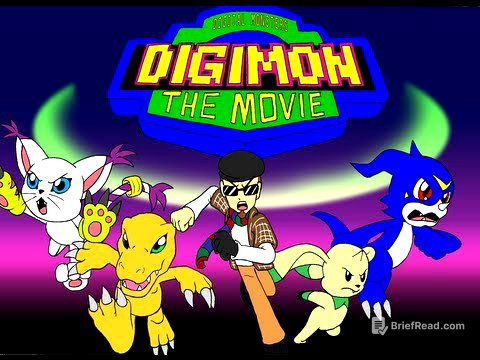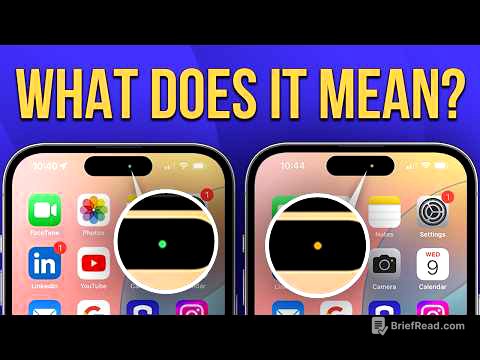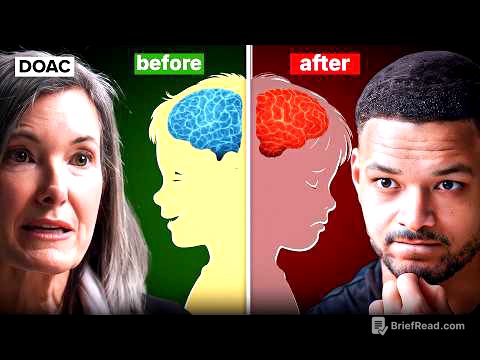TLDR;
This video explores the concept of "choice architecture" and how it's used in online marketing to influence consumer behavior. It covers various tactics, including geo-fencing, A/B testing, the use of cookies, eye-tracking software, and recommendation systems, to demonstrate how subtly and overtly marketers can manipulate purchasing decisions. The video challenges viewers to assess their awareness of these tactics and highlights how personalized nudges and automated systems can drive consumption.
- Geo-fencing and personalized pricing strategies based on location.
- A/B testing of thumbnails and landing pages to maximize clicks and conversions.
- The use of cookies to track user behavior and personalize ads.
- Eye-tracking software to optimize website design and product placement.
- Recommendation systems and abandoned cart reminders to encourage purchases.
Geo-Fencing and Personalized Pricing [0:42]
Geo-fencing involves using a phone's location to create a virtual boundary, allowing marketers to target ads to individuals within that specific area. An example is provided of a taxi app that targeted ads to people arriving at an airport, offering them cheaper rides. However, this technology can be used more aggressively, such as varying prices based on the perceived affluence of customers in different locations. The video references an instance where a cab ride to a luxurious mall was priced higher than the same ride to a regular mall, highlighting how geo-fencing can enable discriminatory pricing.
A/B Testing for Optimization [2:21]
A/B testing is a method used to determine which version of an ad, thumbnail, or landing page performs better by showing different versions to different groups of people. For example, a YouTube channel might test two different thumbnails to see which one gets more clicks. This approach is widely used by companies to optimize their marketing efforts and increase conversions. The video highlights how even small changes, such as the color or text of a button on a landing page, can significantly impact user engagement.
The Role of Cookies in Tracking and Personalization [4:14]
Cookies are used to track user preferences and behavior across the internet, enabling personalized ads. When a user accepts cookies on a website, their activities are monitored, and this data is used to tailor ads to their interests. For instance, if someone browses running shoes on a website, they may start seeing ads for running shoes on other websites they visit. This constant exposure can wear down a user's self-control and increase the likelihood of making a purchase.
Eye-Tracking Software and Heat Maps [5:42]
Eye-tracking software monitors a user's cursor movements on a website to understand where they are looking. Since cursor movements often mirror eye movements, this data can be used to create heat maps showing which areas of a webpage attract the most attention. Businesses can use this information to optimize website design, product placement, and pricing strategies. For example, if a particular watch on a website attracts a lot of attention, the business might increase the prices of other watches to make the popular one seem like a better deal.
Nudges and Psychological Tactics [8:12]
Nudges are subtle prompts or suggestions designed to influence consumer behavior. These can include tactics like displaying "only one in stock" messages or showing pop-ups indicating that other people have recently purchased the same item. These nudges create a sense of urgency or social proof, encouraging users to make a purchase. The video points out that many of these tactics are now available as easy-to-install software plugins, making it simpler for businesses to implement them.
Abandoned Cart Strategies [9:05]
The abandoned cart effect refers to the phenomenon where customers add items to their online shopping cart but then leave the website without completing the purchase. Marketers often use this as an opportunity to upsell by sending automated messages with discounts or special offers to encourage the customer to return and complete the purchase. These messages are triggered after a certain amount of time has passed since the item was added to the cart, and they can be delivered through in-app notifications or emails.
Recommendation Systems and Content as Ads [10:31]
Recommendation systems, such as those used by Amazon, analyze user data to suggest products that the user might be interested in buying. These systems consider past purchases, browsing history, and other factors to provide personalized recommendations. The video concludes by noting that in the age of content marketing, the content itself serves as an ad, with all the aforementioned tactics subtly integrated into the user experience.









